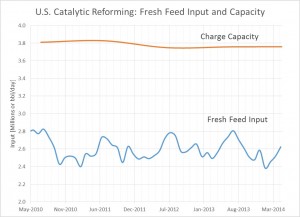Similar to cracking processes, reforming processes add utility to a refinery’s end product, gasoline. Catalytic reforming converts heavy naphtha to high octane isoparaffins and aromatics for gasoline blending. Using a noble metal catalyst, the reformer dehydrogenates, cyclizes, and isomerizes the feed compounds at a high temperature, low pressure, low space velocity, and low H2 byproduct to hydrocarbon ratio. As these conditions promotes C-C breaks and formations, they also lead to slight carbon rejection, which results in coke deposits on the catalyst. Therefore, the end goal of catalytic reforming is to enhance the octane rating of the stream while limiting the amount of coke buildup.
In order to limit the production of petroleum coke, compressed hydrogen is injected into the stream at a relatively low pressure. At high H2 pressures, hydrocracking overtakes reforming processes. While high operating temperatures could inhibit hydrocracking, this parameter is limited by the material defects of the reactor. A high space velocity can also suppress the cracking reaction, however this is detrimental to reforming effectiveness. Ultimately, these parameters must be included in a cost analysis to better define the appropriate operating conditions for a specific feed.
The various process configurations also dictates the optimal working conditions of the reformer. An example from our favorite Honeywell Company, UOP, provides a simplified version of their patented continuous catalyst regeneration (CCR) PlatformingTM Process. Despite the highly favored continuity concept, the seemingly endless list of processes are all very expensive, which explains why in Fig. 1 (below) U.S. refineries will not function at full capacity in the near future. Furthermore, economics are not the only driving forces in catalytic reforming operations: regulations play an important role.
 Fig. 1: The amount of reformer feed remains annual cyclical for the past four years. (Source: EIA)
Fig. 1: The amount of reformer feed remains annual cyclical for the past four years. (Source: EIA)
On May 15th, the EPA’s director signed a rule proposal that could affect conversion processes in refineries throughout the country. The amended regulations would require air concentration monitors along the fenceline of refineries with an expected reduction of 5600 tons per year of toxins and 52,000 tons per year of volatile organic compounds. In order to prolong the life of the catalyst, catalytic reformers include regeneration cycles which burn off coke with air, producing air pollutants. Preceding the catalytic reformer, a hydrotreatment process removes heteroatoms from the feed but subsequently pollutes the atmosphere if not mitigated appropriately. The new rule will eliminate the previous exemption to refinery emissions limits during startup and shutdown, so the aforementioned processes may need additional scrubbing systems. This regulatory scenario illustrates the delicate balance between engineering efficiency (catalyst maintenance) and pollution mitigation.
Let me know if you would like to collaborate while commenting on the new EPA proposals!
Reference:
